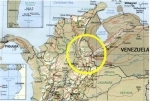Leftist guerrilla groups are allying with neo-paramilitary bands in Northern Santander, a state where these rival groups once battled fiercely for territory. These types of alliances between the left wing guerrillas and criminals groups, descendants of the right-wing paramilitaries, are becoming increasingly common across Colombia, and are forged in the interests of drug trafficking.
El Tiempo reports that the Urabenos and the Rastrojos are buying coca base from the Revolutionary Armed Forces of Colombia (Fuerzas Armadas Revolucionarias de Colombia – FARC) and the National Liberation Army (Ejercito de Liberacion Nacional – ELN) in Catatumbo, Northern Santander, near the Venezuelan border. The ELN are making an estimated 4 billion Colombian pesos (about $2 million) a month from selling coca base, and the FARC earn close to 6 billion pesos (about $3.1 million), according to El Tiempo.
An estimated 3,500 hectares of coca are found in Catatumbo, one of the most battle-torn municipalities in Colombia. The FARC’s 33rd Front is present here, along with at least four ELN “War Fronts Nicolas Rodriguez Bautista, alias ‘Gabino,’ and Eliecer Erlinto Chamorro, alias ‘Antonio García,’ are thought to use this area as a base from time to time.
El Tiempo also refers to a faction of the Popular Liberation Army (Ejercito Popular de Liberacion – EPL), a group which largely demobilized in 1991, as having a presence in the municipality, but this may be a reference to ex-EPL guerrillas who remain in the zone and are now involved in the drug trade.
Reports that Colombia’s new criminal bands (or what are known as ‘bandas criminales’ – BACRIMs) are now buying coca base from the ELN and the FARC in Catatumbo are especially worrying because this region is historically the site of much conflict between these rival criminal armies. The Catatumbo Bloc, a powerful faction of the now demobilized paramilitaries led by warlord Salvatore Mancuso, first entered Northern Santander in 1999. About 800 civilians were killed and another 20,000 displaced in the subsequent violence as Mancuso sought to take control of the production area and thus control the coca from its initial price point, maximizing his profits.
Many of the criminal structures associated with the Catatumbo Bloc did not fully disarm after 2004, when the official demobilization ceremony took place. Several factions, led by mid-level commanders Adrian Jesus Mesa, alias ‘Camilo,’ and Maximo Cuesta Velandia, alias ‘Sinai,’ remained in the region and continued trafficking coca and committing select murders, under the name Aguilas Negras.
If the Urabeños and the Rastrojos also have cells in Northern Santander and are doing business with the FARC, this sits alongside a number of similar alliances already evident across Colombia: the Rastrojos and the ELN in Cauca (the first BACRIM-guerrilla alliance to become manifest), the ERPAC and the FARC in Meta, the FARC and the Paisas, Urabeños and Rastrojos in Antioquia’s Bajo Cauca region. All of these alliances occur in coca-producing regions.
Northern Santander is highly valued by criminal armies not only because of its proximity to Venezuela, but because controlling this area allows for the creation of a trafficking corridor all the way to Uraba, along the Panamanian border, uniting central Colombia with the north and various departure points for the merchandise.
InSight has created a map illustrating the alleged dynamics of the drug trade in Northern Santander. The blue icons represent the major sources of coca production in the region; the red icons are where narcotics are then trafficked into Colombia’s exterior; the green icons are where the drugs are trafficked into Venezuela.
View Northern Santander in a larger map

